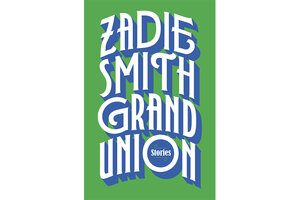Zadie Smith’s ‘Grand Union’ is a superb mélange of short stories
She captures contemporary life through multifarious voices, exploring race and class, gender roles, generational differences, and politics.

“Grand Union” by Zadie Smith, Penguin Press, 256 pp.
Courtesy of Penguin Random House
Arguably one of the greatest writers of her generation, Zadie Smith has published five novels as well as two collections of essays. She’s racked up lists of awards and gathered hordes of fans along the way. Her latest effort, “Grand Union,” is her first book of short stories.
By its very definition, a collection of stories will offer variety, but Smith takes this promise to a new level. The 19 tales of “Grand Union” make up a remarkably diverse collection. Written in a range of styles, her stories capture the complexities of contemporary life through multifarious voices. It’s all here – explorations of race and class, gender roles and generational differences, and a myriad of political debates.
And she explores those perspectives from an equally diverse assortment of genres, including fantasy and memoir. When finishing one story and turning the page to start another, the reader is never sure what will come next. Still, Smith brings her powers of description and her astute observations to each entry, skillfully modifying the language and syntax to match the perspective. The talent that has attracted her loyal following is on full display in “Grand Union.”
Some stories will be familiar to readers. Eight have been published before, mostly in The New Yorker, but 11 of the pieces are new to this collection and are also among its best.
In “The Lazy River,” Smith delves into metaphor to illustrate the inertia of privileged people’s lives. The narrator, a British tourist in Southern Spain, rambles on about the water attraction at the resort, a continuously moving stream that carries everyone forward with no effort required. The river, of course, flows in a circle, never really getting anywhere. It offers an illusion of movement. “We are ‘going with the flow,’” the narrator says.
Each of the stories in “Grand Union” includes a measure of self-reflection, but that element is most evident in “Blocked.” For context, Smith wrote her first novel, “White Teeth,” while she was still a college student at Cambridge University. The book quickly became a bestseller and was later adapted for television. While she experienced incredible early success, Smith has shared in interviews that the experience also set her up for overwhelming self-doubt. How could she possibly repeat that success? Her response, for a while, was to write nothing – or at least, finish nothing. Instead, she got a dog. As this experience plays out for the narrator of “Blocked,” tending to “dear old Butler” is enough to fill the days spent pushing through creative stasis. But in the hands of someone with Smith’s talent, even the mundane activity of walking a dog becomes a treasure of observation and reflection.
It goes without saying that not every story will appeal to every reader. Smith’s candor is unapologetic. Her descriptions can be explicit in ways that some readers might find offensive. Her choices in this area are not gratuitous, but she does include depictions of some of the harsher aspects of the world, and she does so unflinchingly.
This being said, when a reader finds the stories that resonate – that seem familiar because they capture aspects of contemporary life, or express an experience that reveals that people have more in common than it sometimes seems – Smith’s stories seem golden.

